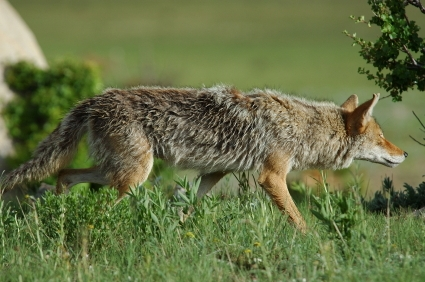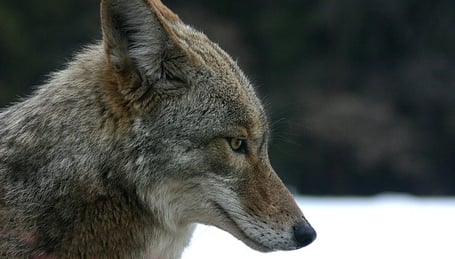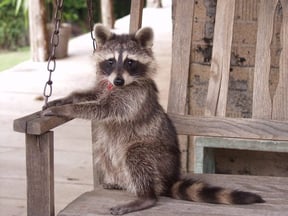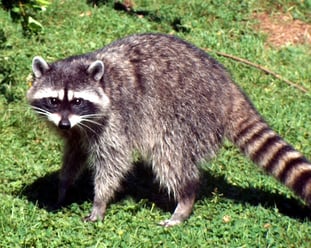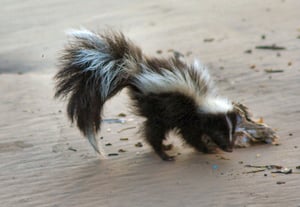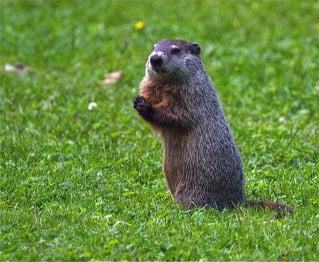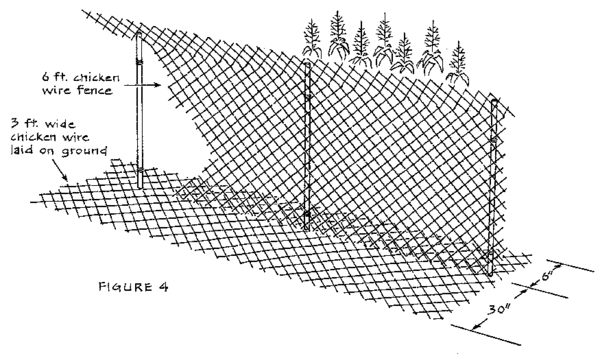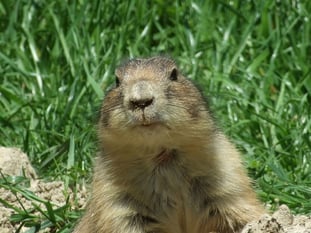Coyotes Raccoons Skunks Mountain Lions/Cougars Woodchucks
Keep Your Loved Ones Safe
As more undeveloped land is taken for house lots and commercial areas, the natural habitat for wildlife is increasingly restricted. Sightings of animals such as coyotes and deer are more frequent. The need for ways to protect pets from potentially aggressive wildlife increases. Here are some strategies in avoiding dangerous interactions with a variety of animals, your pets, and you.
Coyotes
One of the best ways to keep pets safe is to build a wire fence. To protect against coyotes, it is best to use a fence six to eight feet in height. You can either bury 12 inches in the ground or bend it so it lays on top of the ground to the outside of the enclosure as an apron. This will discourage digging.
There are many choices of welded wire fencing and woven wire fencing meshes available:
Welded wire fencing - Galvanized Before Weld (GBW), Galvanized After Weld (GAW) and Vinyl Coated (VC)
- 14 gauge, 1" x 2" and 2" x 4" mesh
- 12.5 gauge, 2" x 4" mesh
Woven wire fencing -
- Apron fence - 17 gauge, 1.5" hex netting mesh
- Deer & Wildlife fence - 12.5 gauge high tensile wire
- 2"x4" mesh non-climb fence - 12.5 gauge
- Emu & Ostrich fence - 12.5 gauge
- Poultry & Garden/Deer & Orchard fence - 14.5 gauge wire
- Naturally, avoiding contact is best
- Dawn and dusk are times when they roam--avoid walking a dog at these times (easier said than done)
- Your dog must be kept on a leash and not far from you
- Dogs are vulnerable to diseases that coyotes harbor--be sure your dogs' vaccinations are updated
- If a coyote comes too close, appear larger by standing on something (a rock or stump) and act in a threatening way, appearing as a danger, not prey
- The only way to keep cats safe is to keep them indoors
- Use noisemaking equipment to ward off a coyote that shows up repeatedly
Raccoons
An Electric Fence
Because Raccoons are excellent climbers and diggers, an electric fence is one method for controlling them. A couple of lines of electric fence at a distance of about 8 inches above
Chicken Wire Probably Won't Stand Up
It's possible to use regular wire fencing, but it must be thick enough so they can't shred it (as they would with something like chicken wire. Louis Page can advise.) Making sure that the fence is far enough from what you want to protect is crucial as they can reach in and do damage. At the top, it is necessary to bend the fencing outward--away from the pen.
Various Notes on Raccoons--
Widespread across North America, when provoked raccoons are vicious. Raccoons aren't looking for a fight, but if cornered and threatened they will eviscerate an animal. Their teeth and claws are little daggers.
- Never feed a raccoon--this is a major reason why they lose their fear of humans and come closer than they should
- Keep pet food indoors
- Make sure that the area around a barbecue is kept clean
- Trash containers lids should be secure
- Pet doors must be raccoon-proof
- Cats are more prone to diseases that raccoons carry--keep your cat's vaccinations up to date
- Don't chase a raccoon away, it may be threatened and invite attack
Not so cute
Skunks
Repelling Skunks
Skunks are not gifted climbers and that's good news for us. There are methods to secure a garden area as skunks dig around plants in search for grubs. To control these diggers, apron fencing, two feet wide, must be partially buried a couple of inches around the circumference of the area you want to protect and at a height of four to five feet. This will discourage dogs and coyotes as well.
Mercifully, skunks find humans and their pets an aberration, so they limit their foraging time to the night. Lights and activity usually repel them, so contact is rare. The spraying happens when a skunk perceives its backed into a corner or surprised. Interestingly, the spraying is used as a last resort and cannot be employed again for three or four days--I know, cold comfort, if you have been sprayed.
- Do not attempt to scare off a skunk--back away
- A dog must be completely controlled for a skunk to back down
- In bad situations, saucers of ammonia may work as a repellent to skunks and many wild animals
- If the worst happens, have nearby: Dawn dishwashing soap, hydrogen peroxide, baking soda, and old towels (to be discarded)
------------------------------------------------------------
Clean up
------------------------------------------------------------
Mountain Lions/Cougars
To Be Sure: Tall Fencing
- Generally, pets are safe in the yard during the day unless there have been reports of a sighting; however, nighttime is another story--this is the time when mountain lions are most active and pets should remain indoors
- Dog leashes of 6 feet or less
- For the protection of your livestock, tall fencing is required; mountain lions are powerful--they can jump up to 15 feet and can leap a distance of 40 feet
- If approached, avoid running, stand your ground, pick up pets and small children
- Do not make eye contact, attempt to appear larger by waving your arms or using your jacket above your head
- Back up slowly
- Give the cougar ample room, making sure to steer clear from cubs, if present
The name "mountain lion" includes cougars, pumas, and panthers. The reference to lions is only related to their color. Cougar is the most common name in North America. Largely found in the western areas of North America, there are some populations east of the Mississippi that are small. There is a subspecies in Florida, called the Florida Panther, which is highly endangered.
Deer are a mainstay of mountain lions and not attracting deer to your property is an important safeguard.
Woodchucks
Small dogs that dig (good example: terriers) can be vulnerable to a woodchuck that is sensing its territory is being invaded. Also, dogs that are protective of their space can be more aggressive to invaders and prompt an altercation. Woodchucks have razor-sharp teeth and can become hostile when cornered; though admittedly this being rare, animals are unpredictable. Cats are generally not threatened. What is most likely threatened on your property is your garden.
Stopping Climbing and Burrowing
The clever woodchuck moves below ground of course, and also above.
- A 6-foot fence is required as a minimum, with 5-foot posts
- Chicken wire should be dug in 10 inches or more below ground level
- Leave a foot of chicken wire unattached from the post at the top and bend it outwards--this prevents the woodchuck from getting a good grip for climbing over the fence
Another possibility is:
- Place 3 feet of chicken wire flat on the ground around the perimeter of the garden
- After which, secure a 4 to 6-foot fence vertically 6 inches in from the chicken wire edge which leave 2 1/2 feet of chicken wire on the outside on the ground
- At the top, leave 12 inches of the chicken wire bent outwards away from the garden, unsecured
- The woodchuck will not be able to dig under the vertical fence because of the 3 feet of chicken wire surrounding the garden
Image from Mass Audubon Society.org
As the Old Farmer's Almanac advises: The best woodchuck deterrent is a fence.
Gophers
Gophers are highly destructive animals. They live in burrows and like to eat many of the plants that people have in their yards and gardens. They are voracious--eating half their body weight each day. If a family of gophers takes up residence in your yard, you could quickly find your lawn taken over by gopher mounds and tunnels. It is easy enough to kill or capture gophers once they arrive, but it would be greatly preferable to keep them out in the first place.
Fencing is a very effective tool for keeping gophers out of your yard. What kind of wire mesh do you need? To keep the gophers out, choose wire mesh fencing with no more than ½-inch openings. Gophers are burrowing animals, so the fence should extend at least 18 inches below the surface. Because it will be highly susceptible to corrosion, choose galvanized steel or vinyl coated fence wire. If your yard is already populated by gophers, you will need to use one of the other methods to get rid of the gophers once you install the fence; otherwise, you could end up with a gopher sanctuary. Electric fencing is another option for restraining gophers.
Bad News on Gophers
Gophers can cause a number of problems. The aesthetic damage to your landscaping is just the beginning. Gophers also eat garden plants like carrots, lettuce, and radishes. They have sharp teeth, and like any other animal, they can be dangerous when they feel threatened. Most famously, and perhaps worst of all, gophers make holes in your yard; these holes are a trip hazard for anybody, but especially for children and elderly individuals. Before you know it, a child could have a sprained ankle and an older person could end up with a broken ankle, wrist or hip. Then there are the diseases they carry--
- Rabies
- Plague and hantavirus
- Monkey Pox, the most common--which exhibits flu symptoms--aches, swollen glands, fatigue and small pustules on the skin
- A burrow system can cover an area of 200 to 2,000 square feet
- Food storage and nesting areas can be as deep as six feet
- Feeding burrows with a 3" diameter are most often 6" to 12" below ground

